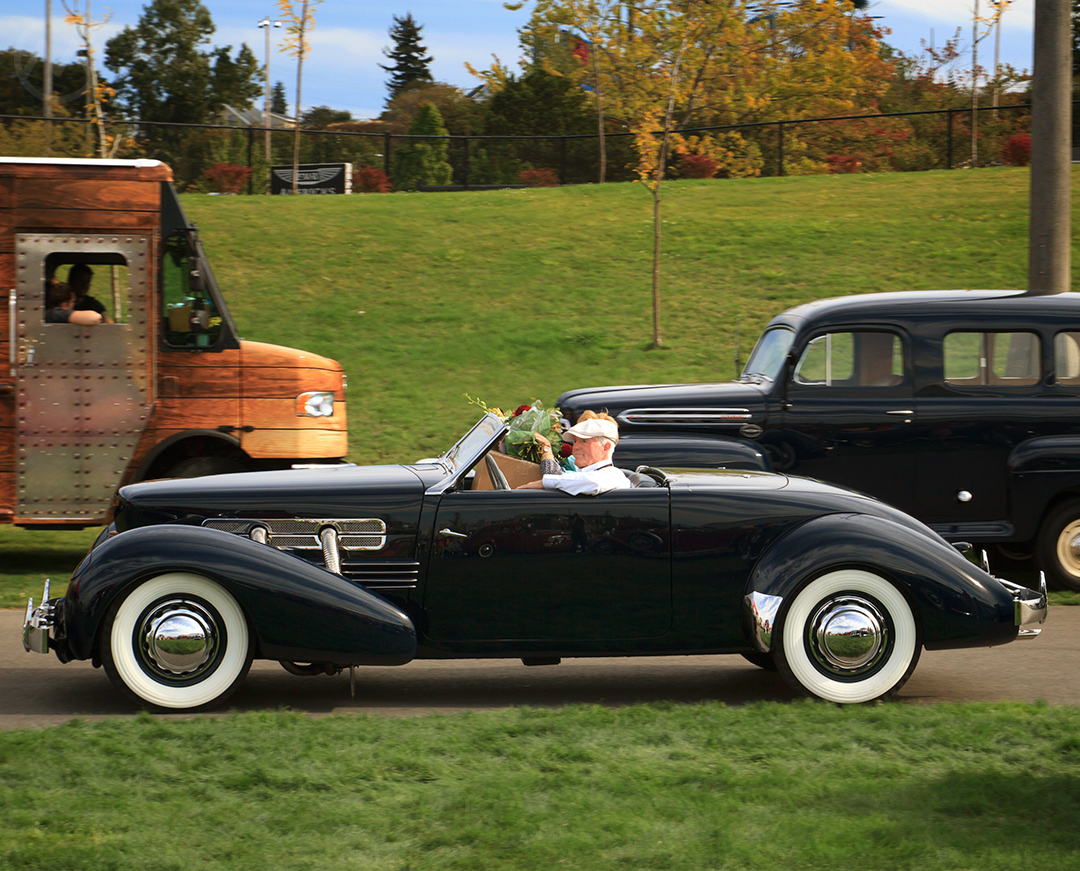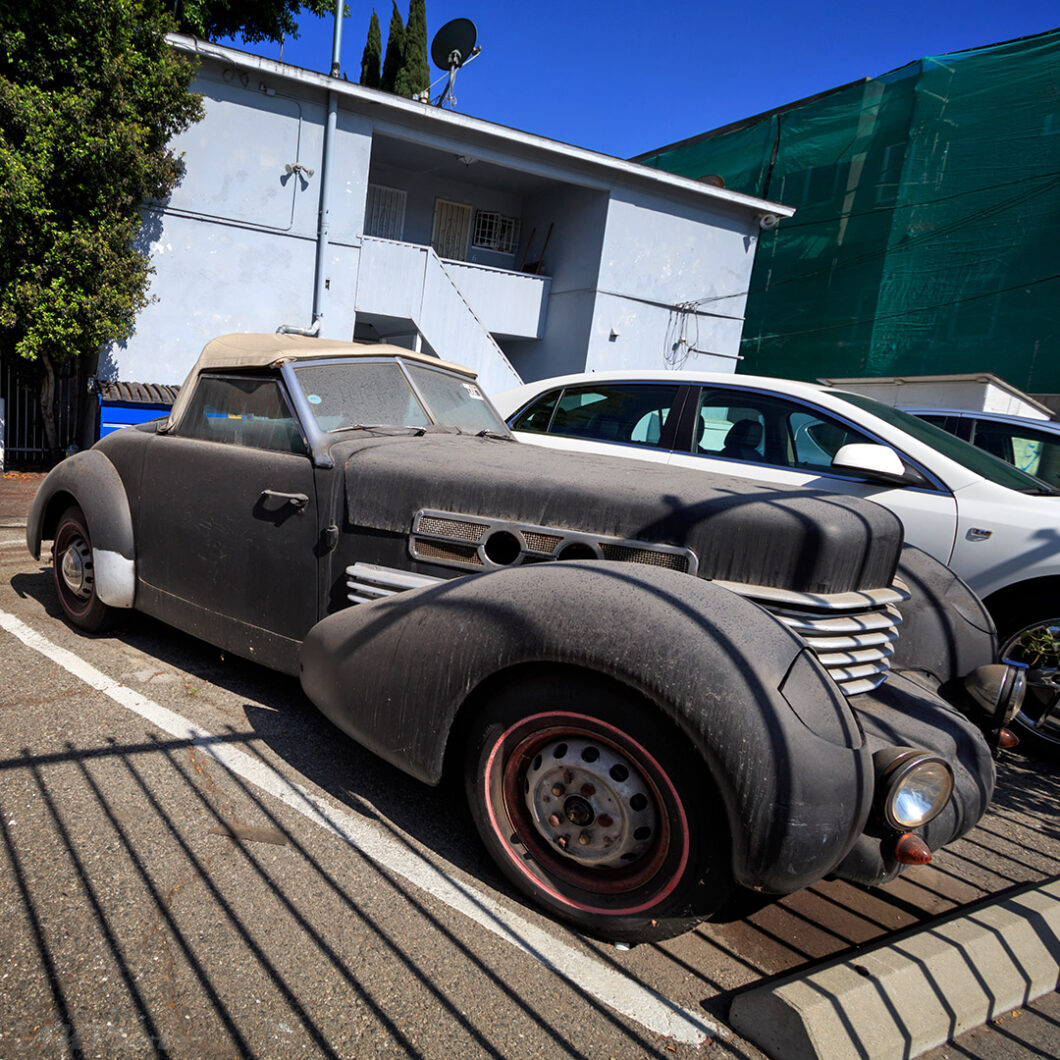It’s a Cord, yes, but look closely and you’ll see that the proportions aren’t quite right. That’s because this Cord is from 1964, not 1936. It’s a Cord 8/10 Sportsman, an attempt to revive the classic marque at, as the name implies, 8/10ths scale. While most replicars are poor imitations of the originals, the 8/10’s creator went to enormous lengths to get his version right, even enlisting the help of the 810/812’s original designer, Gordon Beuhrig.
The story begins in 1940 when an Oklahoma teenager named Glenn Pray saw his first Cord on the street in Tulsa. By that time the 810/812 was old news and E.L. Cord’s empire only a memory. Even production of the related Hupmobile Skylark and Graham Hollywood, built with the old Cord tooling but re-engineered for rear-wheel drive, was soon to wind down. But then as now, the Cord was a very striking car, and not exactly a common sight. Since the Graham and Hupp versions never sold in real numbers either, the shape never got stale.
Pray followed the owner into a local store to find out what it was.
Glenn Pray’s Cord Obsession
Thus was born a lifelong obsession with Cords and, eventually, other products from the Auburn-Cord-Duesenberg empire. Pray grew up to be a high school shop teacher and did some mechanical work on the side, but his passion was Cords. Eventually he owned 13 of them, and even had his students out on the prowl for disused examples.
In a pattern fans of niche old cars might recognize, once Pray was known as “the Cord guy” he became familiar with other Cord and Auburn fans all around the country. While restoring an Auburn in the late 1950s, he met Dallas Winslow, a greying Detroiter who had bought up parts inventories for defunct makes for years and then enjoyed the long tail of income that came after.
While the post-WW2 era had many orphan cars, and we can still see recent orphans like Saabs all over the place, the 1930s were an apocalypse of small makes. WWinslow understood that there was value in the parts and service for cars like Franklins, Velies, Coles, and other orphans, and like later fans of Peugeots and Renaults in the U.S., set about buying up dealerships worth of parts and equipment. In 1938, he bought what was left of Auburn-Cord-Duesenberg, the headquarters building, the parts inventories, and even the name rights, for about $120,000 (about $2.4M today).
By the 1950s, the only people interested in these parts were restorers, but the classic car hobby itself really exploded in that decade (note: in the 50s, “classic cars” meant pre-1931 vintage), and Pray’s sideline turned into restoring the Auburn, among other cars. Once the two met, Pray immediately wanted to buy the company and Winslow’s Jurassic-era Rock Auto of A-C-D parts.
After much negotiation, and with the financial backing of Wayne McKinley, an Illinois Chevy dealer (and Cord fan), that’s exactly what happened. In 1960, Pray’s dream came true and he ended up the head honcho of the long-defunct brands and the parts company Winslow had formed. 350 tons of A-C-D parts were moved from Winslow’s warehouses to a disused Pickle factory in Broken Arrow, Oklahoma.
But Pray wanted more than to supply restoration parts. He wanted to build a new Cord.

The Cord 8/10
In 1961, the 810/812 had been gone for less than 25 years, and 1930s cars were becoming valuable classics rather than old (and complex) junk, even though this design had been considered a classic almost as soon as production ended.
In his travels within the Cord community, particularly after taking on the huge parts inventory, Pray got to meet lots of people – including Gordon Buehrig, the 810’s original designer. In the early 1960s Buehrig was a designer at Ford, and while Pray had in mind some sort of new design, Buehrig convinced him that an 810 replica with modern componentry might be more successful as a niche car.
Pray went back to Oklahoma and began designing a new chassis with help from his brother Jack and local engineer Walter Carlton III. He insisted it be front-wheel drive, but this was years before the Olds Toronado. In the end, scaling it down a little helped make it happen, with a 100-inch (254cm) wheelbase instead of the original 125 (318cm).
On another visit to Buehrig, the designer introduced Pray to the U.S. Rubber Company (USRC), who was at Ford pitching a new bonded-plastic material called Royalite. USRC immediately saw the Cord project as a good candidate for a proof-of-concept that the material could work in car production, and did Pray the enormous favor of offering to pay for the body tooling and for promoting the car.
The welded sheet steel frame was light, and to it was mounted a Corvair Turbo-Air six, supplied by McKinley. The engine drove the front wheels through Citroën Traction Avant components, among other bits, with an independent torsion bar suspension. The Royalite body was light and detailed to look much like the original 810/812 inside. Indeed, the first two cars used new-old-stock 812 dashboards.
What emerged from the pickle factory looked a whole lot like the old Cord from a distance, but drove like a competent modern car. It had side windows and a full top, which made it more practical than some newer non-replicas.

From Replicas to Retro Rip-Offs
Pray was not a businessman, however, and was ousted by his investors when costs got out of control (He kept the A-C-D parts operation and later built Auburn reps). Ninety-one 8/10s were made by Pray’s company and a successor, SAMCO, before the car mutated into the much less happy-looking, V8, rear-wheel drive “Cord II,” which is best forgotten.
This was true of many replicars. In the early 1960s, most were meant to be direct copies or closely inspired by older cars, but over time they tended to morph into bloated pimpmobiles that ended up as their own genre (right into the modern day at Japan’s Mitsuoka).
Pray avoided this tendency in his next project, the Auburn II, which was a direct and largely faithful replica of the 1935 Auburn Speedster rather than an interpretation, though some were modified fairly heavily in the 1970s and 1980s (to their detriment). Pray remained a major fixture in the A-C-D community until his passing in 2011.
We saw the primer gray car in Los Angeles in 2017, mysteriously parked at an apartment complex in North Hollywood. The yellow car, however, is a vintage photo from the OldMotors flashback archive. Based on the other cars, we’re pretty sure the photo dates from Palm Springs in 1964 or 1965, when the cars were still in production.

